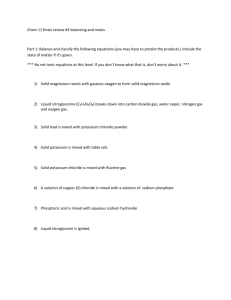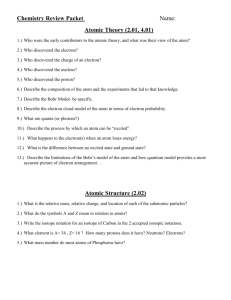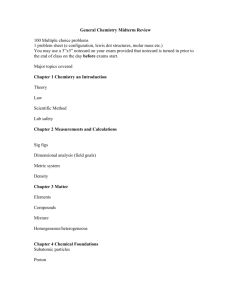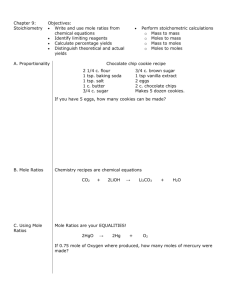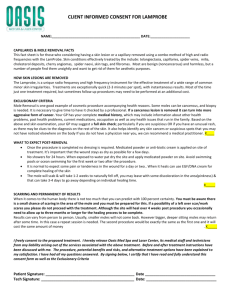CP Chemistry Semester One Exam. 2011-12
advertisement
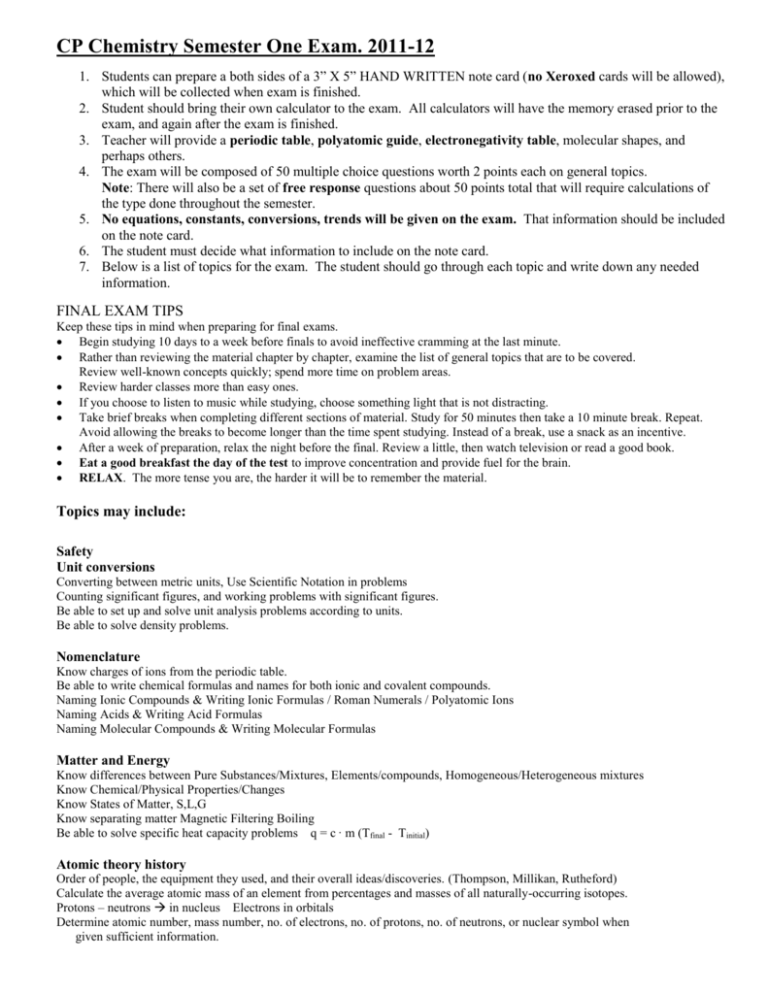
CP Chemistry Semester One Exam. 2011-12 1. Students can prepare a both sides of a 3” X 5” HAND WRITTEN note card (no Xeroxed cards will be allowed), which will be collected when exam is finished. 2. Student should bring their own calculator to the exam. All calculators will have the memory erased prior to the exam, and again after the exam is finished. 3. Teacher will provide a periodic table, polyatomic guide, electronegativity table, molecular shapes, and perhaps others. 4. The exam will be composed of 50 multiple choice questions worth 2 points each on general topics. Note: There will also be a set of free response questions about 50 points total that will require calculations of the type done throughout the semester. 5. No equations, constants, conversions, trends will be given on the exam. That information should be included on the note card. 6. The student must decide what information to include on the note card. 7. Below is a list of topics for the exam. The student should go through each topic and write down any needed information. FINAL EXAM TIPS Keep these tips in mind when preparing for final exams. Begin studying 10 days to a week before finals to avoid ineffective cramming at the last minute. Rather than reviewing the material chapter by chapter, examine the list of general topics that are to be covered. Review well-known concepts quickly; spend more time on problem areas. Review harder classes more than easy ones. If you choose to listen to music while studying, choose something light that is not distracting. Take brief breaks when completing different sections of material. Study for 50 minutes then take a 10 minute break. Repeat. Avoid allowing the breaks to become longer than the time spent studying. Instead of a break, use a snack as an incentive. After a week of preparation, relax the night before the final. Review a little, then watch television or read a good book. Eat a good breakfast the day of the test to improve concentration and provide fuel for the brain. RELAX. The more tense you are, the harder it will be to remember the material. Topics may include: Safety Unit conversions Converting between metric units, Use Scientific Notation in problems Counting significant figures, and working problems with significant figures. Be able to set up and solve unit analysis problems according to units. Be able to solve density problems. Nomenclature Know charges of ions from the periodic table. Be able to write chemical formulas and names for both ionic and covalent compounds. Naming Ionic Compounds & Writing Ionic Formulas / Roman Numerals / Polyatomic Ions Naming Acids & Writing Acid Formulas Naming Molecular Compounds & Writing Molecular Formulas Matter and Energy Know differences between Pure Substances/Mixtures, Elements/compounds, Homogeneous/Heterogeneous mixtures Know Chemical/Physical Properties/Changes Know States of Matter, S,L,G Know separating matter Magnetic Filtering Boiling Be able to solve specific heat capacity problems q = c · m (Tfinal - Tinitial) Atomic theory history Order of people, the equipment they used, and their overall ideas/discoveries. (Thompson, Millikan, Rutheford) Calculate the average atomic mass of an element from percentages and masses of all naturally-occurring isotopes. Protons – neutrons in nucleus Electrons in orbitals Determine atomic number, mass number, no. of electrons, no. of protons, no. of neutrons, or nuclear symbol when given sufficient information. Nuclear chemistry Alpha, beta, gamma Determining nuclear structure Completing & Balancing nuclear transmutation equations Half-life calculations Moles & Mole problems Be able to determine the percent composition of an element in any chemical compound Molar Masses - 1 mole = mass in grams of element or compound H2O is 2(1.008 g/mol H) + 15.999g/mol O =18.015 g/mol H2O Avogadro’s Number is 6.02 x 1023 atom or molecule = 1 mole conversion factors: g x mole g ; mole x g__ mol ; L (at STP) x mole 22.4 L Be able to convert from grams to moles and from moles to grams. Be able to convert from atoms to moles and from moles to atoms. Be able to convert moles to Liters and Liters to moles at STP (where 22.4 L = 1 mole). Convert from mass moles atoms or molecules and back again Convert from atoms or molecules moles mass and back again Convert from Liters (at STP) moles mass and back again Convert from Liters (at STP) moles atoms or molecules and back again ; mole x 6.02 x 1023 atom or molec. 1 mole grams of atoms or molecules of Electrons & Quantum mechanics moles of liters of gas at STP Use and manipulate the 2 Wave equations to determine energies, wavelengths, and frequencies. (E = hc and c = λf ) Use the periodic table to determine electron configurations, determine elements from electron configurations Be able to write and read orbital diagrams. Apply the four types of orbitals; properly identify S P D F blocks on periodic table Be able to determine the number of electrons in an energy level, a sublevel, and an individual orbital. Understand and apply the aufbau principle, Pauli Exclusion Principle, and Hund’s rule. Periodic Trends Know and apply the periodic law. Classify the elements according to s, p, d, and f blocks. Know and apply the octet rule. Know the exception of H and He to the octet rule. Know and apply the periodic trends of atomic radii, ionization energy, electron affinity, and electronegativity, ionic radii, Atomic size Ionization energy Electron Affinity Electronegativity Ionic size Bonding and Naming Ionic bond/ Metal & Nonmetal/ Cation & Anion Charges/ Electrostatic attraction/ Ionic Bonding 3-step problems Covalent Bond/ Nonmetal + Nonmetal Electronegativity difference to determine nonpolar covalent bond/Polar covalent bond Valence electrons – outermost S & P electrons (need to know electron configurations of atoms and ions) Stable Octet Single bond /Double bond/Triple bond Electron dot structures/Shared electron pairs/Unshared electron pairs Valence Shell Electron Pair Repulsion Theory (VSEPR) Predicting shapes - Tetrahedral / trigonal pyramidal/ trigonal planar/ bent / linear Polarity (bond and molecule) Bond Energy problems Topics May Also Include Other Items Missed on this List
